Four Roles of Peking Opera:Sheng, Dan,Jing and Chou
Peking Opera features “character categorization.” In accordance with gender and disposition, characters are divided into four basic roles: sheng (male character type), dan (female character type), jing (character type with a painted face), and chou (a clown). Each role type comes with its own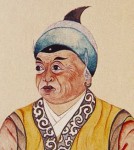 subdivision.
subdivision.
Sheng is a grown-up male. It can be further divided into four types. First, lao sheng playing middle-aged or old men with beard. A lao sheng can be of a type specializing in singing, or a type specializing in martial arts. Lao sheng is the most common male character in Peking Opera. Cheng Changgeng and Tan Xinpei, regarded as founders of Peking Opera, were both lao sheng players. Second, wu sheng, or man with martial skills. A wu sheng can specialize in long weapons or short weapons. The long-weapon wu sheng wears armor, looks dignified and has a moderate skill of singing and recitation, whereas the short-weapon wu sheng wears short clothes and is swift of action. Third, xiao sheng playing young handsome men, most of whom are scholars. This character is frequently portrayed in love stories. Xiao sheng can be further divided into gauze-hat sheng (a court official), fan xiao sheng (scholar using a fan), pheasant-feather fan sheng (a handsome young man), and a poor sheng (a scholar failing to become an official). And fourth, hong sheng playing characters with a red face such as Guan Yu and Zhao Kuangyin.
Owing to the uniqueness of Peking Opera, the role of xiao sheng had long been relatively unimportant. While many plays give prominence to lao sheng and dan (female) roles, xiao sheng is relatively obscure. In the history of Peking Opera, well-known actors playing the xiao sheng role were few in number. Earlier acclaimed xiao sheng players were Cheng Jixian (1874-1944), Jiang Miaoxiang (1890-1972) and Jin Zhongren (1886-1950). Later renowned players were Yu Zhenfei (1902-1993) and Ye Shenglan (1914- 1978). Among xiao sheng impersonators, the only one able to play in shows xiao sheng is the hero was Ye Shenglan.
This is quite different from Western operas where the young hero is very important and is played by highly acclaimed actors. In performance, xiao sheng’s most striking feature is singing and recitation with a combination of real and false voices. His falsetto is relatively high-pitched and fine, making the role distinctively different from lao sheng. On the other hand, xiao sheng’s falsetto is different from that of the dan (female) role. It should be strong but not rough. And it should not be as soft and gentle as a woman’s voice. Fine-tuning nuances in a xiao sheng’s singing is difficult. This is why not many actors have excelled in playing this role like Ye Shenglan.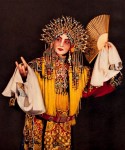
Dan is a general term for female characters. The gentle and quiet is called qing yi and usually represents orthodox yong women. The vivacious is called hua dan and represents girls of ordinary households or extroversive disposition. There are also lao dan (old female), wu dan (female with martial skills) and cai dan which used to be played by male actors. Only “painted face,” or jing, usually has facial makeup. They are all male with a rough, bold and uninhibited character. They speak loudly, shout at the slightest provocation and, if irritated, may use force. The jing roles are divided, too, into the “Singing-oriented” type, or wen jing, and the “martial” type, or wu jing. Actors impersonating jing commonly paint their faces in various styles that range from a single color to be wildering combinations and patterns.
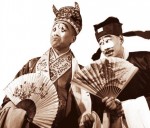 Chou (clown) is the fourth role category in Peking Opera and serves as a foil to the leading character, but it predated other role categories. “No chou role, no play” has long been a popular saying. The chou role represents far more characters than sheng, dan and jing. Such characters can be all kinds of people, from emperors, princes and high-ranking officials to peddlers, servants and soldiers, and to scholars, farmers and traders. They can be old and young, male or female. They can be deaf, blind or lame. And they can be kind-hearted, evil, loyal or treacherous. Their humor and jokes are very much liked by the audience. The chou role category is divided into wen chou (gentle clowns) and wu chou (martial clowns).
Chou (clown) is the fourth role category in Peking Opera and serves as a foil to the leading character, but it predated other role categories. “No chou role, no play” has long been a popular saying. The chou role represents far more characters than sheng, dan and jing. Such characters can be all kinds of people, from emperors, princes and high-ranking officials to peddlers, servants and soldiers, and to scholars, farmers and traders. They can be old and young, male or female. They can be deaf, blind or lame. And they can be kind-hearted, evil, loyal or treacherous. Their humor and jokes are very much liked by the audience. The chou role category is divided into wen chou (gentle clowns) and wu chou (martial clowns).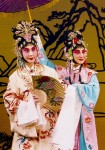
In the past, when they entered an old-type opera school, kids would first learn basic skills that are necessary for all role categories. Afterward, they would part to pursue different lines, specializing in sheng, dan, jing or chou roles. A general practice was that those with regular features play lao sheng (old male role), those with a pretty image play dan (female) roles, those with a rough voice play painted-face roles and those with a comic appearance play chou roles. If it was found later that their appearance, disposition or voice is not suitable for the role they were learning, they could shift to another role category. Actors and actresses worked hard to play their roles well and, after years of performance, their role impersonation would have changed their disposition and even appearance. Observant fans would find that a grown-up male actor with a thin face would likely play a lao sheng role and that one with a broad face, a painted-face role.
At an early stage in the history of Peking Opera, those playing the lao sheng role were leading actors. In Peking Opera, lao sheng are usually mature male characters with a prominent social status. In the feudal society, Peking Opera once played an educational role. Loyal court officials and generals were 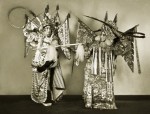 always regarded as the mainstay of society in all dynastic periods. Their character and moral standard represented mainstream values of the society.
always regarded as the mainstay of society in all dynastic periods. Their character and moral standard represented mainstream values of the society.
In the 1920s, the dan role played by Mei Lanfang gained great popularity. Peking Opera then underwent a major shift, from an emphasis on moral education to an emphasis on aesthetic values. Female characters became as important as their male counterparts in Peking Opera.